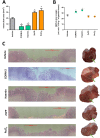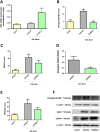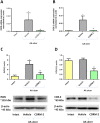Carbon monoxide released from its pharmacological donor, tricarbonyldichlororuthenium (II) dimer, accelerates the healing of pre-existing gastric ulcers
- PMID: 28768046
- PMCID: PMC5610153
- DOI: 10.1111/bph.13968
Carbon monoxide released from its pharmacological donor, tricarbonyldichlororuthenium (II) dimer, accelerates the healing of pre-existing gastric ulcers
Abstract
Background and purpose: Carbon monoxide (CO), a gaseous mediator produced by haem oxygenases (HOs), has been shown to prevent stress-, ethanol-, aspirin- and alendronate-induced gastric damage; however, its role in gastric ulcer healing has not been fully elucidated. We investigated whether CO released from tricarbonyldichlororuthenium (II) dimer (CORM-2) can affect gastric ulcer healing and determined the mechanisms involved in this healing action.
Experimental approach: Gastric ulcers were induced in Wistar rats by serosal application of acetic acid. Animals received 9 days of treatment with RuCl3 [2.5 mg·kg-1 intragastrically (i.g.)], haemin (5 mg·kg-1 i.g.), CORM-2 (0.1-10 mg·kg-1 i.g.) administered alone or with zinc protoporphyrin IX (ZnPP, 10 mg·kg-1 i.g.), 1H-[1,2,4]oxadiazolo[4,3-a]quinoxalin-1-one (ODQ, 5 mg·kg-1 i.g.), NG -nitro-l-arginine (l-NNA, 15 mg·kg-1 i.g.), indomethacin (5 mg·kg-1 i.g.) or glibenclamide (10 mg·kg-1 i.g.). Gastric ulcer area and gastric blood flow (GBF) were assessed planimetrically, microscopically and by laser flowmeter respectively. Gastric mRNA/protein expressions of EGF, EGF receptors, VEGFA, HOs, nuclear factor (erythroid-derived 2)-like 2 (Nrf2), COX-2, hypoxia-inducible factor (HIF)-1α and pro-inflammatory iNOS, IL-1β and TNF-α were determined by real-time PCR or Western blots.
Key results: CORM-2 and haemin but not RuCl3 or ZnPP decreased ulcer size while increasing GBF. These effects were reduced by ODQ, indomethacin, l-NNA and glibenclamide. CORM-2 significantly decreased the expression of pro-inflammatory markers, Nrf2/HO1 and HIF-1α, and up-regulated EGF.
Conclusions and implications: CO released from CORM-2 or endogenously produced by the HO1/Nrf2 pathway accelerates gastric ulcer healing via an increase in GBF, an up-regulation in EGF expression and down-regulation of the inflammatory response.
© 2017 The British Pharmacological Society.
Figures







Similar articles
-
Carbon Monoxide (CO) Released from Tricarbonyldichlororuthenium (II) Dimer (CORM-2) in Gastroprotection against Experimental Ethanol-Induced Gastric Damage.PLoS One. 2015 Oct 13;10(10):e0140493. doi: 10.1371/journal.pone.0140493. eCollection 2015. PLoS One. 2015. PMID: 26460608 Free PMC article.
-
The Protective Role of Carbon Monoxide (CO) Produced by Heme Oxygenases and Derived from the CO-Releasing Molecule CORM-2 in the Pathogenesis of Stress-Induced Gastric Lesions: Evidence for Non-Involvement of Nitric Oxide (NO).Int J Mol Sci. 2016 Mar 24;17(4):442. doi: 10.3390/ijms17040442. Int J Mol Sci. 2016. PMID: 27023525 Free PMC article.
-
Interaction between endogenous carbon monoxide and hydrogen sulfide in the mechanism of gastroprotection against acute aspirin-induced gastric damage.Pharmacol Res. 2016 Dec;114:235-250. doi: 10.1016/j.phrs.2016.11.001. Epub 2016 Nov 5. Pharmacol Res. 2016. PMID: 27825819
-
The Critical Role of Growth Factors in Gastric Ulcer Healing: The Cellular and Molecular Mechanisms and Potential Clinical Implications.Cells. 2021 Aug 2;10(8):1964. doi: 10.3390/cells10081964. Cells. 2021. PMID: 34440733 Free PMC article. Review.
-
Antibacterial effects of carbon monoxide.Curr Pharm Biotechnol. 2012 May;13(6):760-8. doi: 10.2174/138920112800399329. Curr Pharm Biotechnol. 2012. PMID: 22201612 Review.
Cited by
-
Hydrogen Sulfide: From a Toxic Molecule to a Key Molecule of Cell Life.Antioxidants (Basel). 2020 Jul 15;9(7):621. doi: 10.3390/antiox9070621. Antioxidants (Basel). 2020. PMID: 32679888 Free PMC article. Review.
-
Tormentic acid, a triterpenoid isolated from the fruits of Chaenomeles speciose, protected indomethacin-induced gastric mucosal lesion via modulating miR-139 and the CXCR4/CXCL12/PLC/PKC/Rho a/MLC pathway.Pharm Biol. 2023 Dec;61(1):1343-1363. doi: 10.1080/13880209.2023.2249526. Pharm Biol. 2023. PMID: 37623313 Free PMC article.
-
Gaseous Mediators as a Key Molecular Targets for the Development of Gastrointestinal-Safe Anti-Inflammatory Pharmacology.Front Pharmacol. 2021 Apr 29;12:657457. doi: 10.3389/fphar.2021.657457. eCollection 2021. Front Pharmacol. 2021. PMID: 33995080 Free PMC article. Review.
-
Organic carbon monoxide prodrug, BW-CO-111, in protection against chemically-induced gastric mucosal damage.Acta Pharm Sin B. 2021 Feb;11(2):456-475. doi: 10.1016/j.apsb.2020.08.005. Epub 2020 Aug 24. Acta Pharm Sin B. 2021. PMID: 33643824 Free PMC article.
-
Therapeutic Versus Preventative Use of Ginkgo biloba Extract (EGb 761) against Indomethacin-Induced Gastric Ulcer in Mice.Molecules. 2022 Aug 31;27(17):5598. doi: 10.3390/molecules27175598. Molecules. 2022. PMID: 36080365 Free PMC article.
References
-
- Bucci M, Papapetropoulos A, Vellecco V, Zhou Z, Zaid A, Giannogonas P et al (2012). cGMP‐dependent protein kinase contributes to hydrogen sulfide‐stimulated vasorelaxation. PLoS One 7: e53319, https://doi.org/10.1371/journal.pone.0053319. - DOI - PMC - PubMed
-
- Cacanyiova S, Berenyiova A, Kristek F, Drobna M, Ondrias K, Grman M (2016). The adaptive role of nitric oxide and hydrogen sulphide in vasoactive responses of thoracic aorta is triggered already in young spontaneously hypertensive rats. J Physiol Pharmacol 67: 501–512. - PubMed
MeSH terms
Substances
LinkOut - more resources
Full Text Sources
Other Literature Sources
Research Materials

